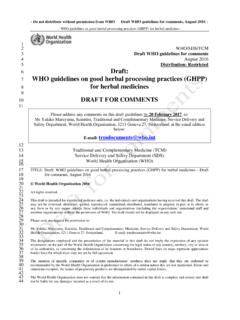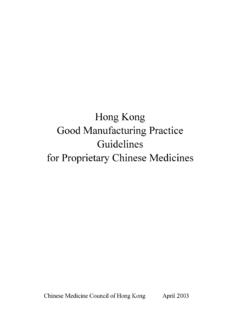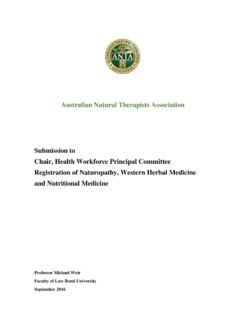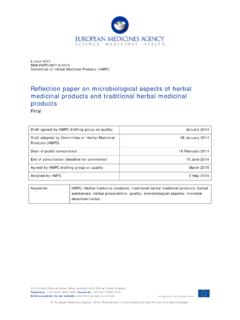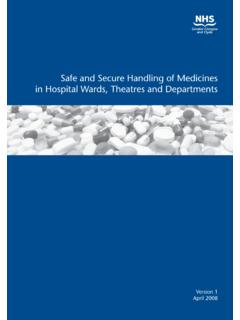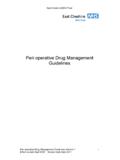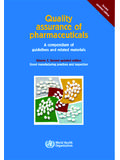Transcription of WHO guidelines on safety monitoring of herbal …
1 WHO guidelines on safety monitoring of herbal medicines in pharmacovigilance systems World Health Organization Geneva 2004. Contents Contents Foreword .. v Acknowledgements ..vii Part I WHO guidelines on safety monitoring of herbal medicines in pharmacovigilance systems 1. General introduction .. 1. Introduction .. 1. Background .. 1. Objectives .. 5. Glossary .. 5. 2. Pharmacovigilance and the WHO International Drug monitoring Programme .. 9. What is pharmacovigilance?.. 9. How does pharmacovigilance operate?.. 10. 3. Challenges in monitoring the safety of herbal medicines .. 13. Regulation, quality assurance and control .. 13. Appropriate use .. 14. 4. safety monitoring of herbal medicines .. 17. Sources of 17. herbal products targeted for safety 19. Reporting of suspected adverse reactions.
2 19. Assessment of case reports .. 22. Data management .. 25. 5. Communication .. 27. 27. Risk communication .. 28. 6. 29. 7. Selected bibliography .. 31. safety monitoring and pharmacovigilance .. 31. Regulation of herbal medicines/traditional 31. Quality assurance/control of herbal medicines .. 32. Rational use of herbal medicines .. 32. Annex 1: List of participants in the WHO Consultation on safety monitoring of herbal Medicines, Vancouver, Canada, 1 3 February 2004 .. 33. Annex 2: The Erice Declaration on Communicating Drug safety Information, 1997 .. 37. iii WHO guidelines on safety monitoring of herbal medicines in pharmacovigilance systems Annex 3: Privacy and the confidentiality of personal health 39. Annex 4: Spontaneous reports from persons other than health-care professionals.
3 41. Annex 5: Model reporting 45. Annex 6: Proposed database management and classification for coding herbal products (the Uppsala monitoring Centre, Uppsala, Sweden) .. 47. Part II safety monitoring of medicinal products: guidelines for setting up and running a pharmacovigilance centre (The Uppsala Moniroring Centre, Uppsala, Sweden, 2000. iv Foreward Foreword The use of herbal medicines continues to expand rapidly across the world. Many people now take herbal medicines or herbal products for their health care in different national health-care settings. However, mass media reports of adverse events tend to be sensational and give a negative impression regarding the use of herbal medicines in general rather than identifying the causes of these events, which may relate to a variety of issues.)
4 The safety of herbal medicines has become a major concern to both national health authorities and the general public. The World Health Organization (WHO) received an urgent request from its Member States, through the national pharmacovigilance centres participating in the WHO International Drug monitoring Programme and drug regulatory authorities, to assist Member States to strengthen national capacity in monitoring the safety of herbal medicines and in analysing the causes of adverse events, and to share safety information at national, regional and global levels. These guidelines have been developed as WHO's immediate response to this request, and to support Member States' efforts in this area in the context of the WHO. International Drug monitoring Programme, which has been in operation since the 1970s.
5 Thus, development of the guidelines has been carried out as a joint project between the Traditional medicine Team (TRM) and the Quality, safety : Medicines Team (QSM) in the Department of Essential Drugs and Medicines Policy (EDM) at WHO headquarters. The recommended approach is to include herbal medicines in existing national pharmacovigilance systems or, where such systems have not yet been developed, to establish comprehensive national pharmacovigilance systems which incorporate coverage of herbal medicines. As described in the Introduction to the guidelines , it is not WHO's intention to suggest that different systems should be instituted for this purpose. However, in view of the unique characteristics of the provision and use of herbal medicines, there are several technical issues that need to be addressed if adequate and effective monitoring is to be introduced.
6 The guidelines therefore identify the particular challenges posed in monitoring the safety of herbal medicines effectively and propose approaches for overcoming them. Special attention is also given to the reporting system for adverse reactions to herbal medicines, and to the analysis of the causes of the reported adverse reactions. In order to handle herbal medicines, in particular, to analyse the causes of adverse events, national pharmacovigilance centres (or equivalent institutions). will need to acquire specific technical expertise. This will include trained personnel in relevant technical areas and facilities to analyse the products concerned, for which there is often insufficient information and lack of access to reliable information support. Many countries currently lack this expertise, in particular, access to suitable analytical laboratories.
7 Member States have therefore recommended the establishment of regional laboratories specializing in v WHO guidelines on safety monitoring of herbal medicines in pharmacovigilance systems the analysis of herbal products. WHO encourages Member States to explore the feasibility of this proposal. To further the implementation of these guidelines , WHO plans to organize a series of training workshops for Member States, in collaboration with the WHO. Collaborating Centres for International Drug monitoring and for Traditional medicine . National capacity in monitoring the safety of herbal medicines will be further strengthened through national training workshops on topics such as, broadening reporting schemes, acquiring technical expertise at national pharmacovigilance centres, and promoting awareness.
8 Training of practitioners who provide herbal medicines will also be crucial. The guidelines also articulate technical issues relating to data management and communication. The Uppsala monitoring Centre, Uppsala, Sweden (UMC) has proposed the herbal anatomical-therapeutic-chemical classification (HATC) as a coding tool to permit the inclusion of individual herbal products in the global WHO database of adverse drug reaction (ADR) reports for pharmacovigilance purposes. The summary explanation of the proposed system by UMC is annexed to the guidelines . Although the system represents a valuable attempt at coding herbal medicines, it may not be perfect for covering all types of herbal products, in particular, traditional medicines that are used under unique concepts and with unique terminologies.
9 Member States are encouraged to offer suggestions, on the basis of their national experience in the day-to-day operation of national pharmacovigilance, as to how classification could be approached in a more comprehensive manner and in a way that meets their national circumstances. WHO, in collaboration with UMC, will work with Member States to continue development of the system. Currently, the majority of adverse events related to the use of herbal products and herbal medicines that are reported are attributable either to poor product quality or to improper use. Inadequate regulatory measures, weak quality control systems and largely uncontrolled distribution channels (including mail order and Internet sales) may have been contributing to the occurrence of such events. In order to expand knowledge about genuine adverse reactions to herbal medicines, and to avoid wasting scare resources for identifying and analysing adverse events, events resulting from such situations will need to be reduced or eliminated.
10 Member States are therefore encouraged to strengthen national regulation, registration and quality assurance and control of herbal medicines. In addition, national health authorities should give greater attention to consumer education and to qualified practice in the provision of herbal medicines. WHO has welcomed the active participation of drug regulatory authorities and national pharmacovigilance centres, among others, in the development of these guidelines . This has provided a useful starting point for strengthening communication between these authorities, which will be needed to ensure progress towards the common goal the safety of herbal medicines. Dr Xiaorui Zhang Coordinator, Traditional medicine Department of Essential Drugs and Medicines Policy World Health Organization vi Acknowledgements Acknowledgements The World Health Organization (WHO) wishes to express its sincere appreciation to Health Canada, in particular the Natural Health Products Directorate, for kindly hosting the WHO Consultation on safety monitoring of herbal Medicines in Vancouver, Canada, in February 2004 (Annex 1), with its financial support.










